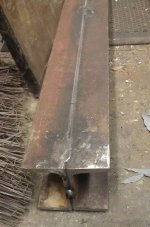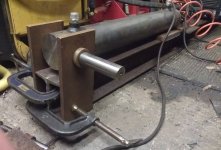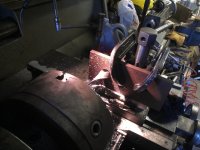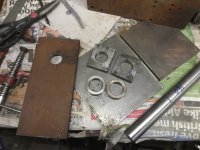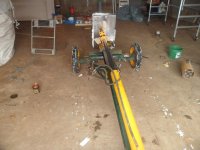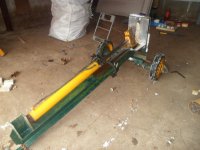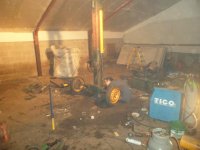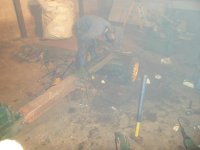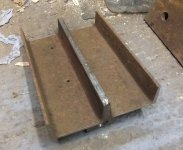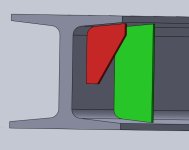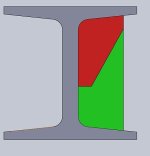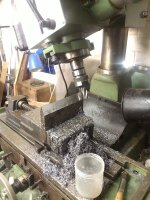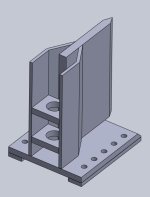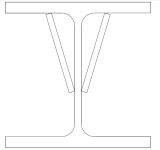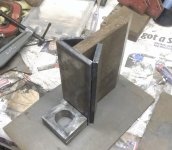mickeyw
Bronze Member
- Joined
- Dec 10, 2012
- Messages
- 64
- Location
- Surrey, UK
- Tractor
- 1987 Renault 68-12, 1981 JD1640, 1973 Ford 3000
Having recently installed a log fire in my living room my attention turned to means of log processing. This fire won't be my main means of heating, just something to enjoy on a miserable, wet and cold English winter Sunday afternoon spent at home with my young family. As such I won't be needing huge quantities of wood.
I have a chainsaw, and a source of good timber, and I am not averse to using a splitting maul, in fact my brother-in-law is an enthusiastic bush crafter and likes doing everything by hand, but I like machinery, and the desire to build my own hydraulic splitter appealed to my engineering side.
Initially I am going to build the bare minimum to check my choice of materials won't self destruct when put under pressure. Once that is proven I will either add some 3-point brackets, or build it onto some wheels for ease of moving around when not in use. To begin with I shall use our JD1640 to provide the hydraulic power. It's a ready-and-waiting source of hyd power.
A future project will include installing a hydraulic PTO to my V8 powered Landrover D90, my other major interest. Typically the PTO setup is not new, but well (ab)used and needs a rebuild . This certainly won't be the cheapest way to run a splitter, or maybe not even the most efficient, but the 'let's see if I can make it work' rule definitely applies.
. This certainly won't be the cheapest way to run a splitter, or maybe not even the most efficient, but the 'let's see if I can make it work' rule definitely applies.
Materials:
Well having read so many splitter build threads on here I am highly envious of the apparent availability of second hand and surplus supply hydraulic components in the USA. The UK does not seem to like this way of recycling, a great shame really.
My search for hydraulic components started on the UK version of that well known auction site. Good used items don't seem to turn up that often, but I found a number of guys selling new log splitter kits of cylinder, spool, hoses and QD connectors. I am not the world's most patient guy, and having sown the seed of the idea I couldn't wait to get on with the build, so I settled for these parts new.
I now have an 80mm bore cylinder with 40mm rod and 500mm stroke. It was sold as being a 10 tonne kit, hopefully this will be adequate for my needs. The wood types I expect to find might include English oak, Pine, possibly Ash and who know what else.
As for the steel, I already have some 100x50mm (4"x2") C-section steel channel that has been in the hedgerow for a number of years. I know an H or I section beam would be best, but I reckon 2 lengths of C section welded back to back will stand a good chance. It is to all intents free, as it's been there so long. I have modelled this beam in 3D CAD using Solidworks, and run some stress analysis tests on it based on a 10 tonne force, and deflection looks minimal.
Here is an initial mock up of what I am planning.
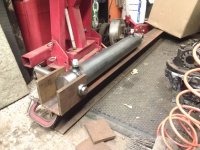
I also have some 100x12mm (4"x1/2") mild steel plate knocking about, so that will be used for various brackets once I figure out what they will be.
I have a chainsaw, and a source of good timber, and I am not averse to using a splitting maul, in fact my brother-in-law is an enthusiastic bush crafter and likes doing everything by hand, but I like machinery, and the desire to build my own hydraulic splitter appealed to my engineering side.
Initially I am going to build the bare minimum to check my choice of materials won't self destruct when put under pressure. Once that is proven I will either add some 3-point brackets, or build it onto some wheels for ease of moving around when not in use. To begin with I shall use our JD1640 to provide the hydraulic power. It's a ready-and-waiting source of hyd power.
A future project will include installing a hydraulic PTO to my V8 powered Landrover D90, my other major interest. Typically the PTO setup is not new, but well (ab)used and needs a rebuild
Materials:
Well having read so many splitter build threads on here I am highly envious of the apparent availability of second hand and surplus supply hydraulic components in the USA. The UK does not seem to like this way of recycling, a great shame really.
My search for hydraulic components started on the UK version of that well known auction site. Good used items don't seem to turn up that often, but I found a number of guys selling new log splitter kits of cylinder, spool, hoses and QD connectors. I am not the world's most patient guy, and having sown the seed of the idea I couldn't wait to get on with the build, so I settled for these parts new.
I now have an 80mm bore cylinder with 40mm rod and 500mm stroke. It was sold as being a 10 tonne kit, hopefully this will be adequate for my needs. The wood types I expect to find might include English oak, Pine, possibly Ash and who know what else.
As for the steel, I already have some 100x50mm (4"x2") C-section steel channel that has been in the hedgerow for a number of years. I know an H or I section beam would be best, but I reckon 2 lengths of C section welded back to back will stand a good chance. It is to all intents free, as it's been there so long. I have modelled this beam in 3D CAD using Solidworks, and run some stress analysis tests on it based on a 10 tonne force, and deflection looks minimal.
Here is an initial mock up of what I am planning.

I also have some 100x12mm (4"x1/2") mild steel plate knocking about, so that will be used for various brackets once I figure out what they will be.
